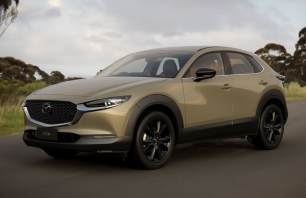Seven-seat SUVs tend to really be a 5+2 combo, where the rear two seats are for kid- or emergency-use only. You'll be pleased to find that all passengers enjoy a decent amount of space in each row in the CX-80. The third row is still a little cosy for an adult but my 6ft2 brother managed to get back there without too many grumbles. However, we all giggled as he sort of fell in due to the lack of handholds (sorry, Mack).
Otherwise, the 170mm ground clearance and wide door apertures make it an easy SUV to get in and out of. The doors are heavy and sometimes miss their 'hold' position if you open them too quickly, making them swing back. My eight-year-old got whacked a few times because of it!
Amenities and storage are best in the first and second rows with front occupants enjoying those heated seats, two USB-C ports, a 12-volt socket and wireless charging pad. You also get dual-zone climate control, and powered seats with adjustable lumbar support. The seats are well-padded but fairly narrow and short in the base, making it easy to fatigue on longer journeys.
Storage includes a large glovebox that can hold a manual and a fair bit more, a shallow but handy middle console because of its dual-opening lid and a total of four drink holders. There's a sunglasses holder but not much else for smaller loose items.
In the second row you get two map pockets, a small storage bin in each door and a total of six drink holders. There's also individual reading lights, two USB-C ports, climate control, directional air vents, a fold-down armrest and retractable sunblinds (always a winning feature in my house).
The third row gets four drink holders, two USB-C ports and two directional air vents.
Feedback from my passengers (kids and adults alike) hasn't been great for the air-conditioning system with all complaining how long it took for the rear two rows to cool down. The low and awkward positioning of the air vents also prevents direct air flow to passengers. The third row is impacted by this as the passenger's legs cover them.
The rest of the technology is solid with the multimedia system offering a rotary dial operation. The system hasn't seen any recent updates, so if you're familiar with the Mazda system, you'll get along just fine.
The built-in satellite navigation is simple enough to use and the wireless Apple CarPlay is easy to connect to. There's also wireless Android Auto. Call connections remained consistent but feedback was that there seemed to be a fair bit of background noise on my end during calls.
Rounding out the interior is the boot space which offers a level loading space, retractable cargo blind and underfloor storage which houses the tyre repair kit. There's also a 12-volt socket and 220-volt/150W AC socket housed on a side panel.
With all three rows up, you get 258L of capacity and that figure jumps up to 566L when the third row is stowed. The CX-8 offered more boot space but the CX-80 is still respectable for the annual family road trip. Plus you get a powered tailgate function in the Touring model, which is always appreciated.






